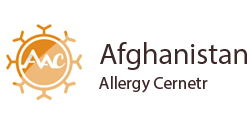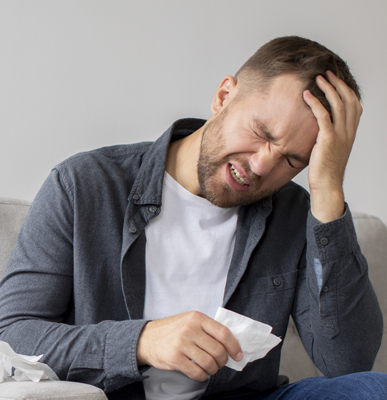Symptoms of an Allergy Headache
An allergy headache is a general term that describes any head pain that results from an allergy. The pain may be directly due to allergy symptoms, or the allergy symptoms may trigger pain in people with chronic migraines. Distinguishing one from the other can be difficult.3
Sinus Headaches
Sinus headaches involve pain in the sinus area of the face, including the cheeks and forehead. These headaches commonly occur as a result of allergic rhinitis, also known as hay fever. Seasonal allergic rhinitis is most often caused by tree or grass pollens. These pollens are carried in the air at different times of the year.4
Under normal circumstances, the sinuses are open cavities that allow you to breathe air and drain mucus. With allergic rhinitis, the overreaction of the immune system causes the passages to swell. This leads to sinusitis (sinus inflammation) and the development of sinus pain and pressure.3
Symptoms of a sinus headache can range from mild to severe and typically include:3
- Pain, pressure, and fullness between the eyes and/or behind the cheeks or forehead
- An aching sensation in the upper teeth or jaw
- Worsening pain when you lie down or bend over
- Stuffy nose and trouble breathing
- Fatigue
Migraine Headaches
An allergy headache can sometimes have little to do with sinus inflammation. Rather, the pain may be caused by any number of environmental factors that are known to trigger migraines.
Migraines are more than just “really bad headaches.” They are a recurrent and sometimes debilitating neurological disease that can cause a variety of symptoms, including:5
- A visual disturbance called an aura that manifests with bright lights, flashing lights, or shapes
- A pulsing, throbbing pain usually on one side of the head
- Extreme sensitivity to light, sound, or smells
- Nausea and vomiting
What Does an Allergy Headache Feel Like?
Allergies can cause two types of headaches: migraine and sinus headaches. Migraine headaches tend to cause pulsating or pounding pain on side of the head, often with nausea or vomiting. Sinus headaches occur in the middle of the face behind the eyes or forehead, typically with nasal congestion.6
What Causes an Allergy Headache?
The cause of an allergy headache can vary based on whether allergic rhinitis or a migraine is involved. Because the causes can overlap, diagnosing the underlying condition can take time.
How to Treat Allergy Headaches
The treatment of allergy headaches differs based on whether the underlying cause is allergic rhinitis or a migraine.
Sinus Headaches
Sinus headaches are treated by reducing the effects of histamine while managing the pain and congestion. Treatment options include:12
- Over-the-counter painkillers: These include Tylenol (acetaminophen) and nonsteroidal anti-inflammatory drugs like Advil (ibuprofen) or Aleve (naproxen).
- Oral antihistamines: These include non-drowsy formulations like Claritin (loratadine) and older formulations like Benadryl (diphenhydramine) that can help you sleep comfortably at night.
- Antihistamine nasal sprays: These nasal sprays work locally to counteract the effects of histamine in the nose.
- Oral decongestants: These include pseudoephedrine, a drug that can reduce the swelling of blood vessels throughout the body, including those in the nose.
- Decongestant nasal sprays: These work by directly shrinking swollen blood vessels in the nose.
- Steroid nasal sprays: These temper inflammatory substances in the nasal passages. While effective, they can take several days to work.
- Nasal irrigation: This involves manually flushing the nasal passages with a saline solution or purified water (either with a bulb syringe, spray bottle, or neti pot).
How Headaches Are Treated
Migraine Headaches
Migraines are often not treated the same way as sinus headaches, which is why it is important to differentiate the two before treatment.
Treatment options for migraines include:13
- Over-the-counter painkillers: The same drugs used to treat sinus headaches may be appropriate for mild to moderate migraines.
- Triptans: These are a class of drugs used in the first-line treatment of moderate to severe migraines. They include Axert (almotriptan), Relpax (eletriptan), and Frova (frovatriptan).
- Dopamine agonist antiemetics: These second-line drugs, which treat migraines and accompanying nausea, include Haldol (haloperidol) and Reglan (metoclopramide).
- Dihydroergotamine (DHE): This is an injectable or nasal drug commonly used when migraines fail to respond to other drug treatments.
- Corticosteroids: These anti-inflammatory drugs are delivered by injection to reduce the severity and recurrence of migraines in emergency situations. Dexamethasone is one of the most common options.
















